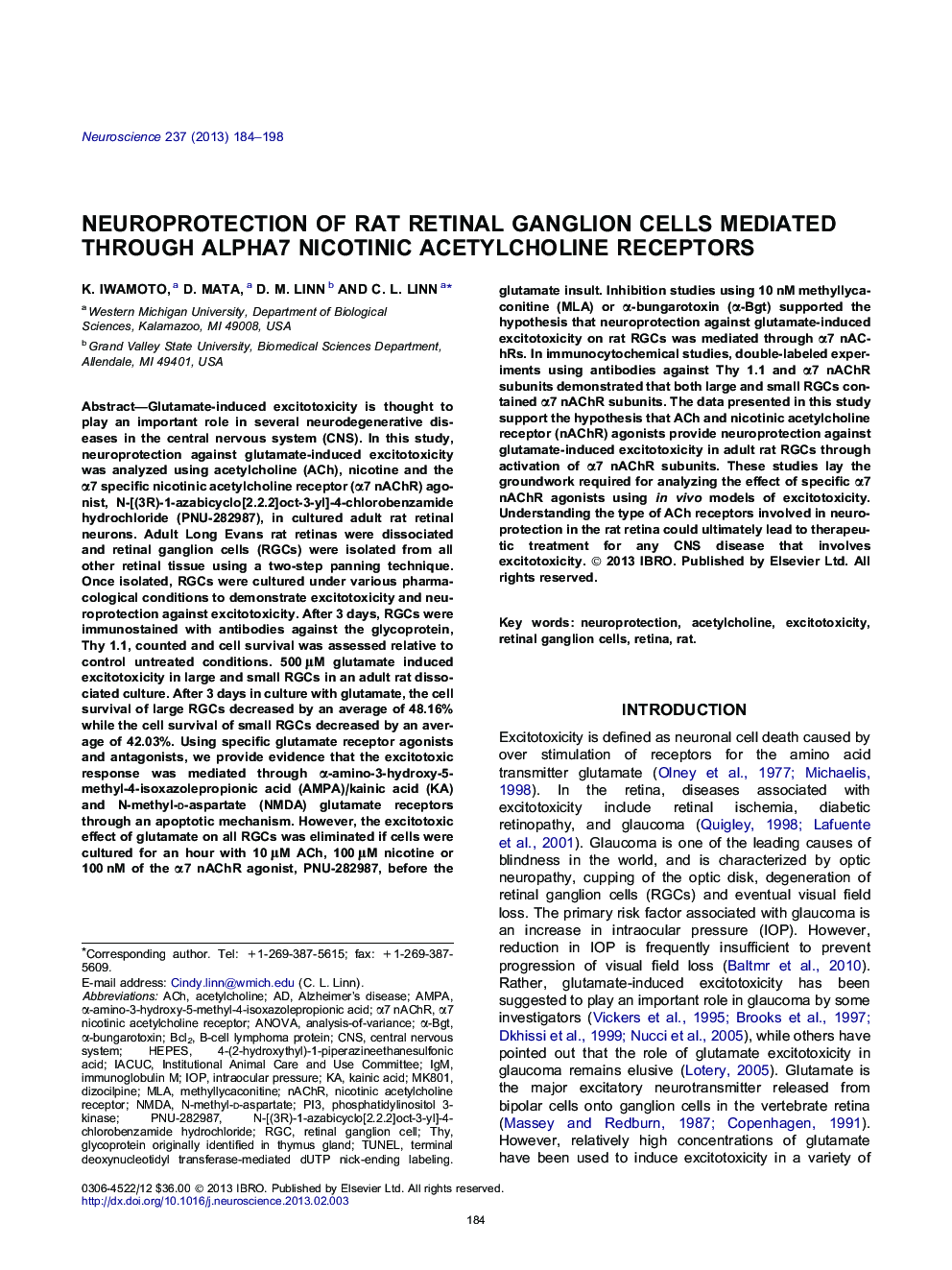| کد مقاله | کد نشریه | سال انتشار | مقاله انگلیسی | نسخه تمام متن |
|---|---|---|---|---|
| 6275225 | 1614839 | 2013 | 15 صفحه PDF | دانلود رایگان |

Glutamate-induced excitotoxicity is thought to play an important role in several neurodegenerative diseases in the central nervous system (CNS). In this study, neuroprotection against glutamate-induced excitotoxicity was analyzed using acetylcholine (ACh), nicotine and the α7 specific nicotinic acetylcholine receptor (α7 nAChR) agonist, N-[(3R)-1-azabicyclo[2.2.2]oct-3-yl]-4-chlorobenzamide hydrochloride (PNU-282987), in cultured adult rat retinal neurons. Adult Long Evans rat retinas were dissociated and retinal ganglion cells (RGCs) were isolated from all other retinal tissue using a two-step panning technique. Once isolated, RGCs were cultured under various pharmacological conditions to demonstrate excitotoxicity and neuroprotection against excitotoxicity. After 3 days, RGCs were immunostained with antibodies against the glycoprotein, Thy 1.1, counted and cell survival was assessed relative to control untreated conditions. 500 μM glutamate induced excitotoxicity in large and small RGCs in an adult rat dissociated culture. After 3 days in culture with glutamate, the cell survival of large RGCs decreased by an average of 48.16% while the cell survival of small RGCs decreased by an average of 42.03%. Using specific glutamate receptor agonists and antagonists, we provide evidence that the excitotoxic response was mediated through α-amino-3-hydroxy-5-methyl-4-isoxazolepropionic acid (AMPA)/kainic acid (KA) and N-methyl-d-aspartate (NMDA) glutamate receptors through an apoptotic mechanism. However, the excitotoxic effect of glutamate on all RGCs was eliminated if cells were cultured for an hour with 10 μM ACh, 100 μM nicotine or 100 nM of the α7 nAChR agonist, PNU-282987, before the glutamate insult. Inhibition studies using 10 nM methyllycaconitine (MLA) or α-bungarotoxin (α-Bgt) supported the hypothesis that neuroprotection against glutamate-induced excitotoxicity on rat RGCs was mediated through α7 nAChRs. In immunocytochemical studies, double-labeled experiments using antibodies against Thy 1.1 and α7 nAChR subunits demonstrated that both large and small RGCs contained α7 nAChR subunits. The data presented in this study support the hypothesis that ACh and nicotinic acetylcholine receptor (nAChR) agonists provide neuroprotection against glutamate-induced excitotoxicity in adult rat RGCs through activation of α7 nAChR subunits. These studies lay the groundwork required for analyzing the effect of specific α7 nAChR agonists using in vivo models of excitotoxicity. Understanding the type of ACh receptors involved in neuroprotection in the rat retina could ultimately lead to therapeutic treatment for any CNS disease that involves excitotoxicity.
⺠Activation of α7 nAChR induces neuroprotection. ⺠PNU 282987 protects RGCs from glutamate-induced excitotoxicity. ⺠Rat RGCs contain α7 nAChR subunits. ⺠Implications for diseases of the CNS associated with excitotoxicity.
Journal: Neuroscience - Volume 237, 1 May 2013, Pages 184-198